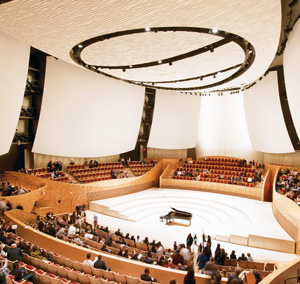
The important Ludwig van Beethoven (1770-1827) is alive and well in Silicon Valley, right now, for everyone to see, hear and experience. In a beguiling set of circumstances, both Stanford and SJSU are currently unleashing a smorgasbord of contexts in which to shatter the space-time continuum and contemplate all things Beethoven.
The brand-new, 112-million-dollar, 842-seat Bing Concert Hall opened at Stanford last weekend, and it will now serve as the venue for the Stanford Symphony’s Beethoven Project, kicking off this weekend. The symphony will devote its entire season to the performance of all nine Beethoven symphonies, and there will be educational concerts and Beethoven-centric curricula. The symphony will even tour Europe this summer with the theme “In Beethoven’s Footsteps.”
As I walked through the Bing Concert Hall a few days before it opened, workers were still putting the final touches on things. It is an immaculate venue, with the symphony and the Stanford Philharmonia Orchestra now permanent residents. The hall itself is “in the round,” that is, the seats are arranged in a “vineyard” format, with seating sections surrounding the stage and beginning on the same level as the performance platform. The furthest seat is only 75 feet from the conductor.
Even better, there are no right angles anywhere inside the hall. Every component of the architecture flows like a stream, in wavelike fashion, throughout the space. The acoustics took priority, and everything else was built around the acoustics. In the bigger picture, the idea is to ensure that every Stanford student has access to and appreciates the arts.
Aside from the concert space, there are huge restrooms, a cafe, a veranda, studio/rehearsal spaces and even foyer sections that open to the surrounding greenery, providing a natural transition between architecture and nature. Throw in plenty of free parking and dozens of bike racks, and you have what’s probably the most modern concert venue anywhere around here. Even the dressing rooms have floor-to-ceiling windows that face the landscaping outside.
In a complementary set of circumstances, over at SJSU, the Ira F. Brilliant Center for Beethoven Studies at SJSU launches an exhibit, “Beethoven’s Vienna,” on Jan. 26, continuing for the rest of the spring semester. If you haven’t been there, the Center now officially contains the largest collection of Beethoven materials in the Western hemisphere, a treasure trove of historical artifacts, scores, research materials, prints, facsimiles, objets d’art, historic keyboard instruments and real-life goods, including the famous Guevara Lock of Beethoven’s hair.
Named after Dr. Alfredo Guevara, one of those who originally purchased the lock of hair at Sotheby’s, London, nearly 20 years ago, the lock is a fully authenticated piece of Beethoven’s hair, residing under a glass display for all visitors to see. The Center is similarly organizing a tour, this October, to Vienna, so folks can walk in Beethoven’s footsteps.
Upon my visit to the Center last week, volunteer Richard Sogg, M.D., sat down at the historical fortepiano and played a version of “Tennessee Waltz,” before regaling me with the Herb Alpert & the Tijuana Brass classic “Spanish Flea” on another keyboard. I immediately felt reconnected with my alma mater.
Following Sogg’s shenanigans, curator Patricia Stroh gave me the lowdown on the new exhibit, which will provide glimpses into the years 1792 to 1827, when Beethoven lived and worked in Vienna. We will see: engravings of bombardments, florists, honey sellers and camels; a lottery ticket; an 1803 Viennese cookbook; a zograscope (an viewing device that imparts the illusion of depth) and vue d’optique prints; the last quill pen Beethoven ever used; music engraving tools; one of Malzel’s first metronomes; as well as a Biedermeier coffee grinder and coffee maker. Whew!
But for me, the synchronistic aspects here are even more mind-blowing because I was just in Vienna a few months ago, lurking in the shadows of Beethoven’s former houses and haunts myself—but with no foreknowledge there would be celebrations of such things right in my own part of the world come January.
The pillars of self, time and space once again underwent a profound transfiguration. The past, present and future have compressed into one. Applaud, my friends, the column is over.



